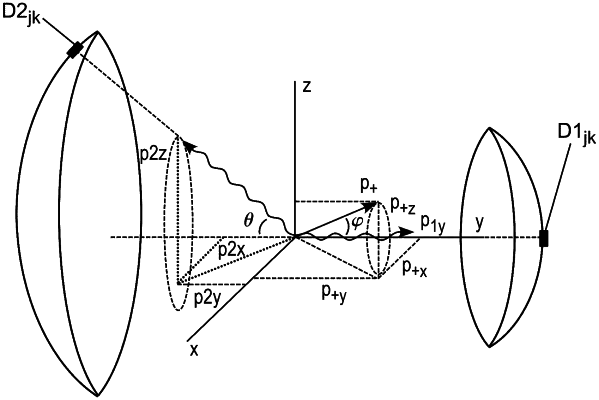| CPC G01T 1/2985 (2013.01) [A61B 6/037 (2013.01); A61B 6/5211 (2013.01); G01T 1/2992 (2013.01)] | 11 Claims |

|
1. The method of improvement of the positron source position determination in an object investigated by the positron emission tomography utilizing Doppler effect comprises the following steps:
the investigated object containing a source of positrons, which annihilate through the production of pairs of annihilation photons, is placed into a system of n position and energy-sensitive detectors (Di) of gamma radiation each comprised of a system of detection elements (Dijk), whose placement is described by a three-dimensional coordinate system, where one of the pairs of annihilation photons interacts in the first of the affected detection elements (D1jk) and the second one of this pair of annihilation photons interacts in the second of the affected detection elements (D2jk), which then record the data about such events consisting of the coordinates of positions of the interactions in the three-dimensional coordinate system describing the positions of the detection elements (Dijk) in relation to the investigated object, the time of interactions of the annihilation photons with the affected detection elements (D1jk) and (D2jk), and energies E1 and E2, which the individual photons from the pair left in the affected elements (D1jk) and (D2jk), and then the mutual assignment of the events recorded in the detection elements (D1jk) and (D2jk) to the individual pairs of annihilation photons is performed according to their time of interactions and the events are transmitted through the interface, used to control the detectors (Di) and detection elements (Dijk) and for reading the signal from them, to a control and evaluation computer, in which they are analyzed for the purpose of the reconstruction of a three-dimensional depiction of the spatial placement of the positron emitters in the source of the positrons in the investigated object, while the analysis concerns both, the coincidental events of registrations of the annihilation photons with energies in the interval from 507 keV to 513 keV to obtain the spatial depiction of the positions of positron annihilations, and the coincidental events of registrations of the annihilation photons with significantly Doppler shifted energies outside of that interval, which simultaneously fulfill the condition that the sum of the measured energies of these photons is, within the energy resolution of the affected detection elements (D1jk) and (D2jk), equal 1022 keV in CMS, which, according to the kinematics of positron annihilation, proves, that the positrons annihilated in flight closer to the position of the positron source, and thus allow to refine the positron source position determination in the investigated object initially obtained from the aforementioned spatial depiction of the positions of positron annihilations taking into account the annihilation photons with energies from 507 keV to 513 keV.
|